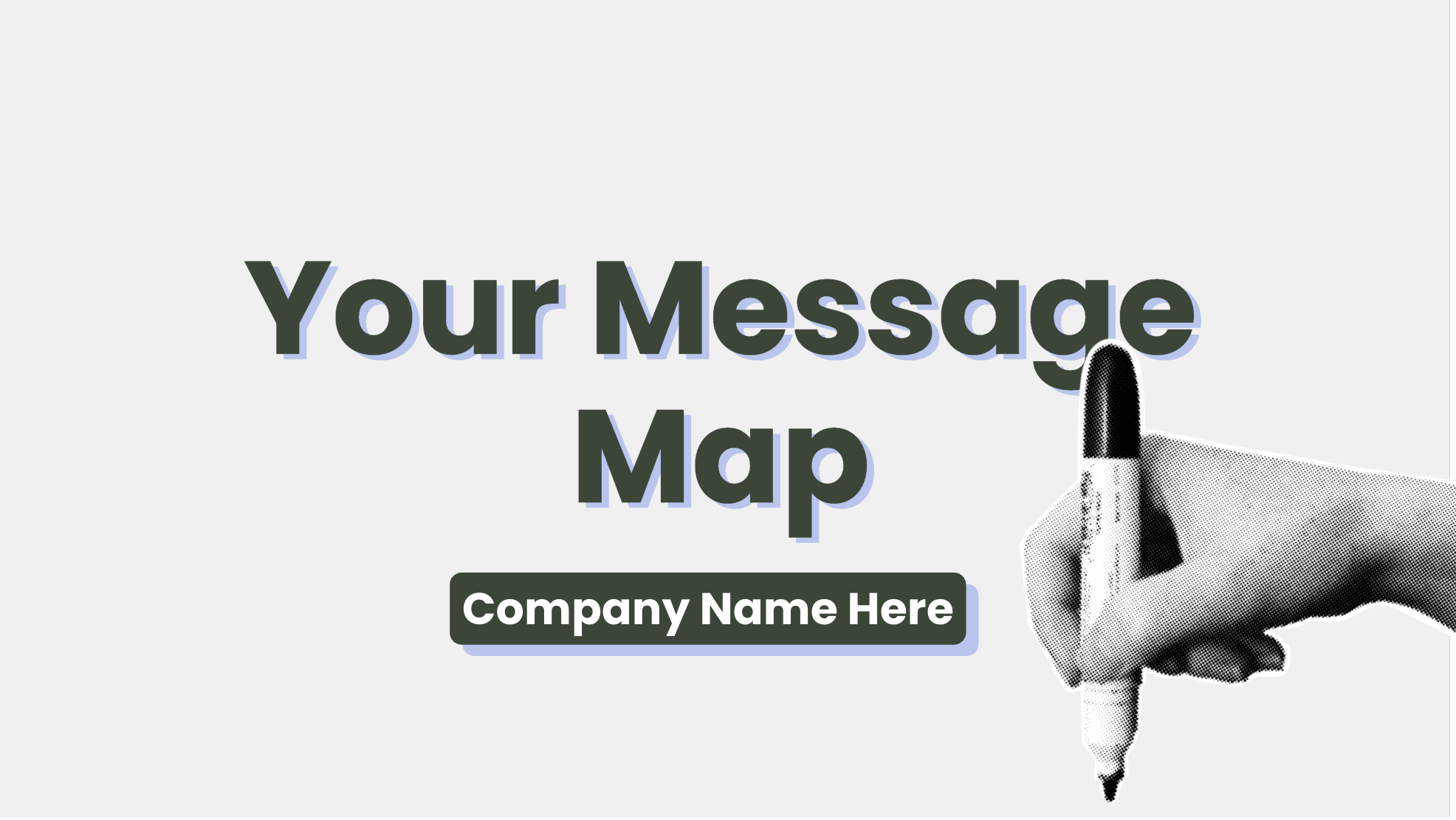Why Brand Messaging Is the First Lever You Should Pull
At Laurel Leaf we go on (and on) about the importance of building a strong messaging foundation for months now. But here’s the thing:
Talking about strategy isn’t enough. You’ve got to build it. Codify it. Share it. Align around it.
Because the alternative is… chaos.
Knowledge buried in Slack. Conflicting value props across decks and docs. Endless rounds of “Does this still sound right?” because no one remembers what the last agency wrote.
At Laurel Leaf, we treat messaging as your company’s constitution, not a Google Doc. It’s the strategic bedrock we build everything on. And after refining it across dozens of client engagements, we’ve developed a way to make this process repeatable, collaborative, and genuinely useful:
Our Message Map—the flagship output of our brand messaging agency process.
If you’re looking for a brand messaging agency that doesn’t just create decks but builds a Message Mapping system that scales, you’re in the right place.
This post walks through exactly what goes into it, and how it helps teams like yours turn scattered ideas into strategic alignment, stronger positioning frameworks, and content that converts.
1. ICP, Buying Teams, and the Power of Disqualification
Before you can communicate value, you need to know exactly who you’re talking to. Our Message Map starts with:
- ICP: Company stage, industry, size, priorities, and tooling. For us? Seed to Series B SaaS/AI startups with lean GTM teams.
- Buying Team: Champions, decision-makers, end users. Because you’re rarely selling to just one person.
- Psychographics: What they value. What they fear. Where they hang out. What triggers action.
- Anti-Customer: Who not to target. If your messaging attracts everyone, it resonates with no one.
We believe in defining both who you serve—and who you actively want to repel.
This clarity helps prevent misalignment down the road and ensures your team stops chasing poor-fit leads.
2. Jobs to Be Done: Functional, Social, Emotional
Too many messaging frameworks stop at “what we do.” Ours digs deeper:
- Functional: What are people hiring you to do? For us: clarify positioning, build strategic content, drive conversions.
- Social: What image are they trying to project? (E.g. “I chose a smart partner who gets our space.”)
- Emotional: What deeper need are you satisfying? Confidence. Trust. Relief from the overwhelm.
Understanding the JBTD layers ensures your strategic messaging speaks to both logic and emotion.
3. Desired Outcomes and Core Problem
Instead of jumping straight to pain points, we zoom out:
- Desired State: What does success actually look like for your buyer?
- Core Problem: What’s blocking them from achieving that?
- Symptoms: The nagging issues that surface when your messaging is misaligned or unclear.
Your job isn’t just to solve pains. It’s to pave the path to their desired future.
This shift in focus—away from patching problems and toward enabling outcomes—is a key differentiator of effective brand messaging agency work and a cornerstone of any strong positioning framework.
4. Why Now? Stakes, Triggers, and The Cost of Inaction
The most powerful messaging introduces urgency.
- What external market shifts make this the right time to act?
- What internal dynamics (funding, hiring, pressure from leadership) are pushing your buyer to prioritize messaging?
- What happens if they don’t fix this?
Doing nothing is always an option. Your messaging needs to show why it’s the wrong one.
A skilled brand messaging agency will help you identify these urgency triggers and turn them into conversion levers with compelling, strategic messaging.
5. Your POV, the Villain, and the Old vs. New Way
What do you believe about your market that others don’t?
At Laurel Leaf, we believe:
Most early-stage teams skip foundational messaging and jump straight into content—which leads to fragmented efforts and flat results.
We help clients define:
- Their point of view
- The villain (made popular by StoryBrand.)
- The old way vs. new way comparison
This is where you start standing for something—and stop sounding like everyone else. It’s also where your positioning framework starts to take shape.
6. Build Your Positioning Foundation
Now that we’ve clarified the audience, needs, and narrative, it’s time to build structure.
- Category: What kind of solution are you? What mental box should buyers place you in?
- Main Capability: What does your solution enable?
- Process: How does it work? What should buyers expect once they’re in?
People don’t just buy outcomes. They buy confidence in your process.
This is one of the most overlooked areas where a brand messaging agency can add real value: translating abstract value into a tangible positioning framework and roadmap.
7. Value Propositions = Capability + Benefit + Proof
The most misunderstood part of messaging? Value props.
A good value prop isn’t just a feature or a benefit. It’s a mini-argument:
Capability + Benefit + Proof = Value Proposition
For example:
- Message Mapping Workshops: Align your entire GTM team in one week → Led Autoblocks and Fifth Dimension through this with measurable results.
- ICP-Specific Value Prop Development: Stand out in a crowded market → Helped Vanilla Steel 3x landing page conversions.
This is how you go beyond vague promises to actual differentiation—and strengthen the core of your strategic messaging.
8. Deleted Workflows (Especially for AI Startups)
For AI companies, we include a dedicated slide:
- Workflows to Be Deleted: Which slow, error-prone, manual processes are you eliminating?
This framing helps articulate impact in clear, relatable terms—critical in a market flooded with hype.
It’s one reason our brand messaging agency has become a go-to partner for AI startups navigating early GTM challenges and building relevant positioning frameworks from scratch.
9. The Pitch Stack: One-Liner, First Floor, Tenth Floor
Because sometimes you have 10 seconds—and sometimes you have 3 paragraphs.
We help teams develop:
- One-liner: Who you are, what you do, who it’s for
- One-paragraph pitch: A slightly expanded version
- Tenth-floor pitch: A full strategic narrative for deeper conversations
Clarity at every level—crafted with the support of your brand messaging agency and embedded into a complete positioning framework.
10. Language to Use—and Avoid
We capture the voice of your audience and map landmines:
- What phrases resonate?
- What terms alienate them?
- Are there regulatory red flags (especially in health tech or fintech)?
We’ve seen great messaging fall flat because it sounded good to the company—but not to the customer. Avoid that trap with help from an experienced brand messaging agency focused on precision and strategic messaging.
11. Bonus Slides: Modular, Customizable, Practical
No two companies are the same. So our Message Map is:
- Modular by segment, product, use case, or vertical
- Tailored to your customer journey
- Flexible enough to update as your business evolves
Use it to write your homepage, revamp your deck, brief your agency, or align your founders before fundraising. It scales with you—just like a great brand messaging agency should.
The Takeaway: This Isn’t Just a Framework. It’s a Foundation.
One PMM at a Series B AI company called it “probably the best framework I’ve ever used.”
We’ve used this Message Map with:
- Teams who needed to rebuild their homepage in 2 weeks
- Founders pitching to enterprise buyers
- CMOs aligning cross-functional teams on one narrative
Every time, it brings clarity. And clarity creates momentum.
If you’re serious about creating a content engine that drives growth, start with your message.
And if you want a brand messaging agency that makes the strategic stuff actually usable—while delivering a positioning framework your team can rally around?
You can check out our Message Mapping page for packages and pricing.



